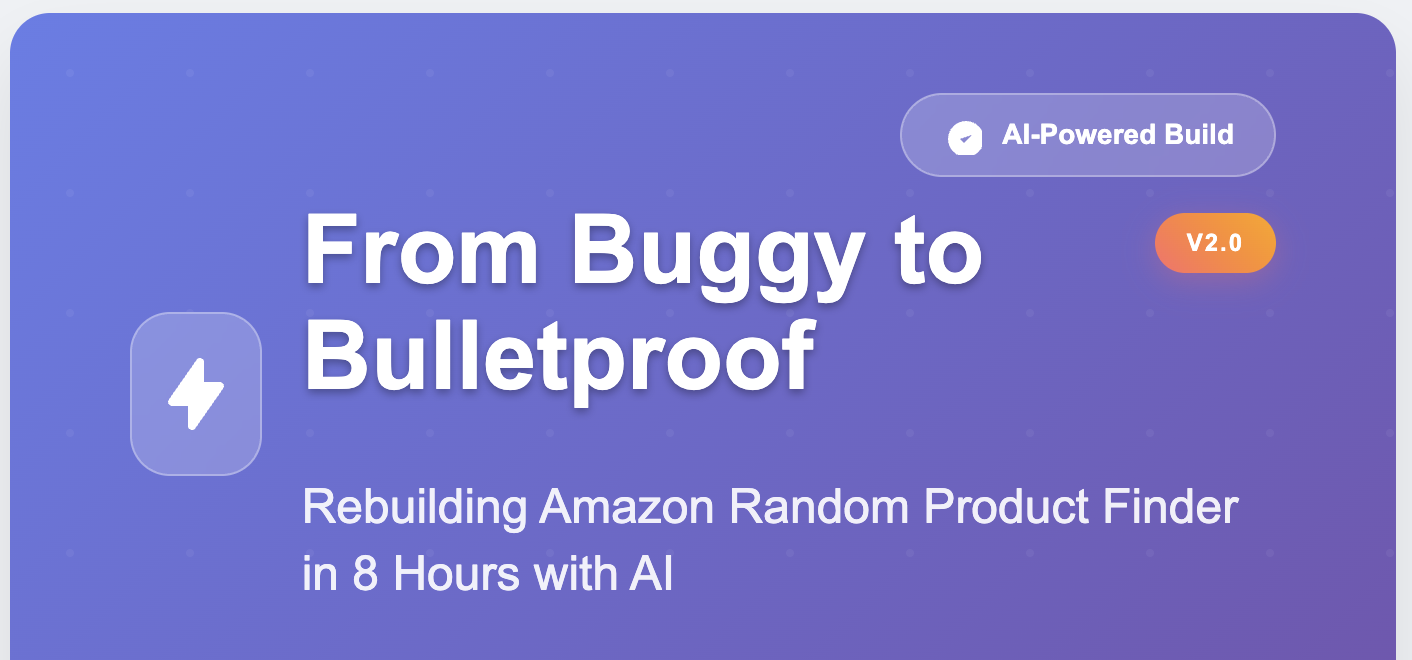How I scrapped my NodeJS implementation and built a more robust Python-based serverless solution with the help of Google’s Jules and Claude 3.7 Sonnet
The Problem: When Success Breeds Failure
After launching my first Amazon Random Product Finder, I thought I was done. The site was live, generating affiliate revenue, and people were actually using it. But as traffic grew, so did the bugs.
The NodeJS implementation that seemed elegant in development became a nightmare in production. Lambda timeouts, inconsistent API responses, and mysterious crashes were making the user experience unpredictable. Something had to change.
The Solution: A Complete Rewrite in Record Time
Rather than patch the existing system, I decided to start fresh. This time, I would leverage the latest AI development tools to build something more robust. My weapon of choice? Google’s new AI developer Jules, followed by iterative improvements with Windsurf and Claude 3.7 Sonnet.
The goal was ambitious: rebuild the entire application from scratch in less than 8 hours.
Act I: Jules Takes the Lead
I started by asking Jules to create a Python-based Lambda function using the Amazon Product Advertising API (PAAPI). The conversation was remarkably natural:
“Build me a random product finder using the Amazon Product Advertising API with Python”
Within minutes, Jules had:
- Set up the complete serverless framework structure
- Created the
serverless.ymlconfiguration - Implemented the core
handler.pywith PAAPI integration - Generated the
requirements.txtwith proper dependencies - Provided detailed setup and deployment instructions
The initial implementation was clean, following Python best practices and AWS Lambda optimization patterns. But more importantly, it worked reliably from the first deployment.
Act II: Windsurf and Claude Polish the Diamond
While Jules provided an excellent foundation, the real magic happened when I took the code to Windsurf (powered by Claude 3.7 Sonnet) for iterative improvements. This is where the application transformed from functional to exceptional.
Key Enhancements Added:
1. Advanced Category Filtering
- Implemented comprehensive category mapping
- Added user-friendly category names that convert to Amazon’s SearchIndex values
- Ensured proper handling of categories like “ToysAndGames” and “ToolsAndHomeImprovement”
2. Enhanced User Interface
- Complete UI redesign with modern card-based layout
- Added category dropdown with intuitive icons
- Maintained existing price filtering functionality
- Professional footer and blog integration
3. Performance Optimizations
- Favicon optimization (reduced from 1.1MB to 1.8KB – over 600x smaller!)
- SEO improvements with robots.txt and sitemap.xml
- CloudFront integration for global content delivery
4. Robust Infrastructure
- Proper AWS Lambda deployment with environment variables
- S3 bucket configuration for static assets
- CloudFront distribution for performance and reliability
What Made This Possible?
1. AI Tool Synergy Each AI tool brought unique strengths:
- Jules: Excellent at initial architecture and PAAPI integration
- Claude 3.7 Sonnet: Superior at iterative improvements and optimization
- Windsurf: Perfect development environment for AI-assisted coding
2. Python’s Serverless Advantages The switch from NodeJS to Python proved crucial:
- More predictable memory usage in Lambda
- Better error handling and debugging
- Cleaner integration with AWS services
- More stable PAAPI client libraries
3. Iterative Development Rather than trying to build everything at once, the AI-assisted approach allowed for rapid iteration:
- Start with working core functionality
- Add features incrementally
- Test and optimize at each step
- Deploy frequently with confidence
Lessons Learned: The Future of AI-Assisted Development
This project reinforced several key insights about working with AI development tools:
1. Start Simple, Iterate Fast AI excels at creating working prototypes quickly. Don’t over-engineer the initial version.
2. Tool Specialization Matters Different AI tools have different strengths. Jules excelled at initial setup, while Claude was better for refinement and optimization.
3. Human Guidance is Still Essential While AI can write the code, human insight guides the architecture decisions and identifies optimization opportunities.
4. Speed Enables Experimentation When you can rebuild an entire application in 8 hours, you’re more willing to experiment with better approaches.
The Bottom Line
The second iteration of my Amazon Random Product Finder isn’t just better – it’s in a completely different league. What started as a buggy NodeJS experiment became a robust, feature-rich application that actually delivers value to users.
More importantly, this project demonstrates how AI development tools are changing the game. The barrier to rebuilding and improving software has dropped dramatically. When fixing bugs takes longer than starting over, why not start over?
The future belongs to developers who can effectively collaborate with AI tools, leveraging their speed and accuracy while providing the creative direction and business insight that only humans can offer.
Check out the live application: Amazon Random Product Finder
Read about the original version: The Good, The Bad, and The Random: Launching a Monetized Site with AI

Leave a Reply